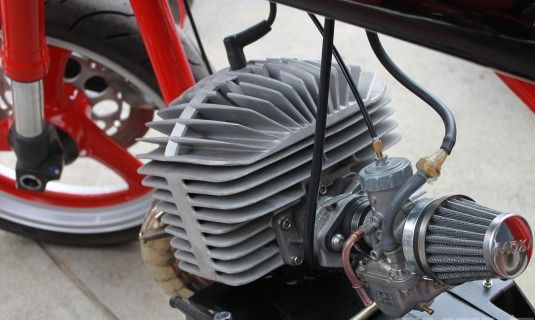Many older riders and a fair number of younger idealists love the look of engine cooling fins. As a small boy, I came to love their mysterious shapes when I saw them on airliner engines. Time-lapse photography of motorcycle engines from earliest days would show rudimentary black iron fins at first, quickly growing bigger and bigger as engineers learned to pull more and more power from engines, generating more and more waste heat.
When iron fins grew so long that their tips became cool and ineffective, materials that conducted heat better became necessary. First came aluminum-bronze around 1930—a practical compromise because it conducted heat about twice as well as iron. And like iron, it was tough enough that engine valves could seat directly on it—no seat inserts to work loose, as happened so often with early aluminum alloys.
When even more cooling capacity was needed, as 500cc cylinders approached 30 horsepower, the next step was to cast the combustion chamber in aluminum-bronze and then to cast over it the rest of the cylinder head, including the fins, in aluminum, an excellent conductor of heat. This was called “bimetal construction.”
Norton used it until 1950 on their Manx racing singles, which won so many Isle of Man TT races. Honda’s variant, employed on their exotic road-racing engines of the 1960s, was to cast the combustion chamber “skulls” in austenitic iron (whose heat expansion is similar to aluminum’s), then cast the rest of the head in aluminum.
The final step was an all-aluminum head, made of an alloy heat-resistant enough to retain pressed-and-shrunk-in hard valve seat rings. Many methods of seat ring installation have been used—casting the head around them, screwing them in, knurling and forging surrounding metal against them, and heat-shrinking them in place.
A problem with air-cooling: While a vehicle’s power requirement rises roughly as the square of its speed, the velocity of free-stream cooling air varies only directly with speed. Practice was always ahead of theory on this one—if engines ran so hot that they detonated, designers gave the next model more fin area. The result was generally engines with too much fin area for low-speed operation and not really enough to sustain long full-throttle running. Yet millions of serviceable engines were built around this compromise. As soon as the head became hot enough to evaporate pretty much all the fuel, you were ready to go. Design engineers saw to it (mostly) that air-cooled engines were given compression ratios low enough not to wreck themselves with detonation when made shimmering hot by a high-speed summer dash across Death Valley.
Constant operating temperature has many advantages, but water-cooling isn’t the only way to achieve it. Blower-cooled engines (old Porsches!) can have temperature-controlled valves to match cooling airflow to load, and large aircraft piston engines had movable cowl flaps for that purpose. But in their case, the only “thermostat” was a watchful flight engineer, scanning his instrument panel.
Great deeds have been done with cooling fins, and some of us can’t forget it.










24
Comment